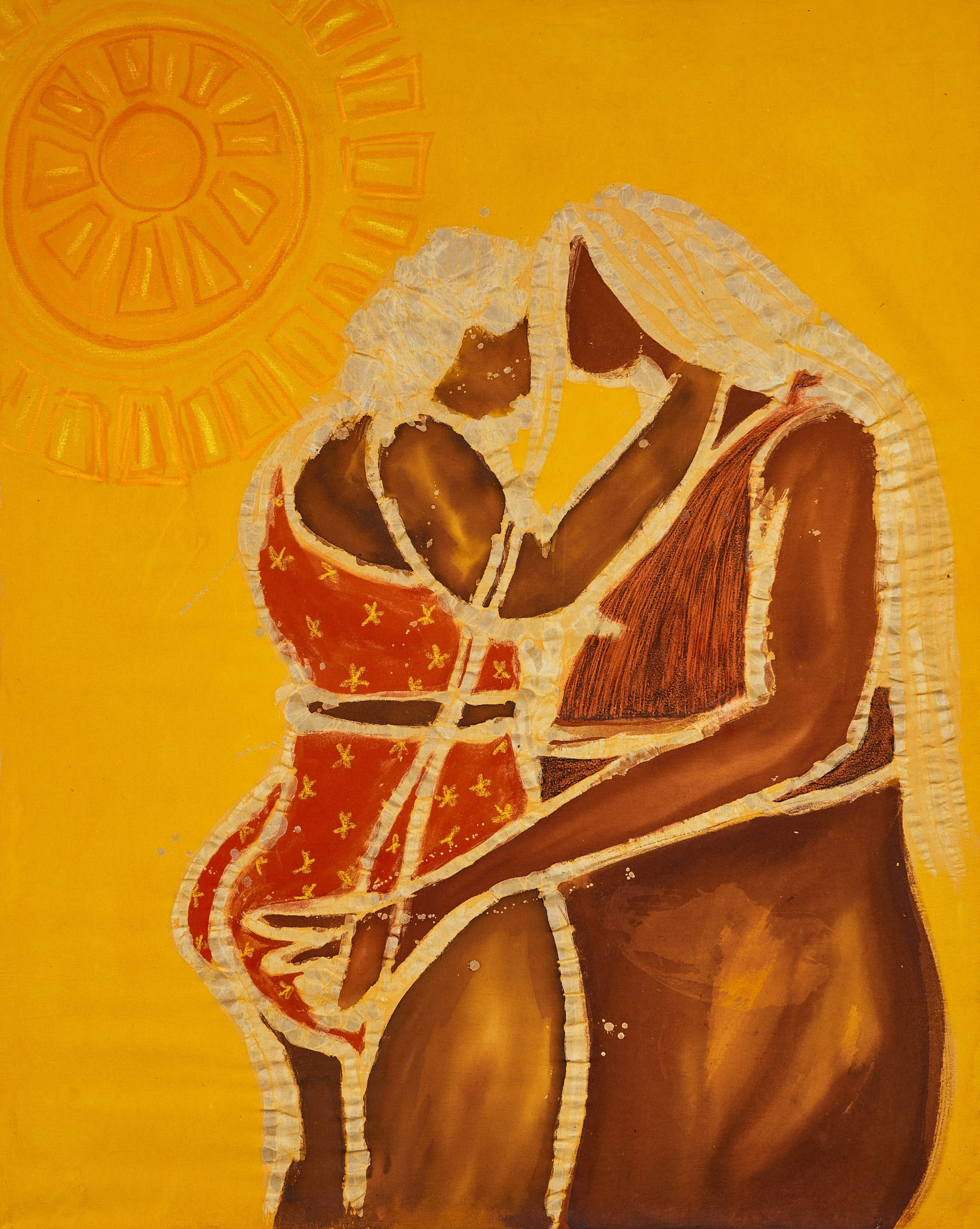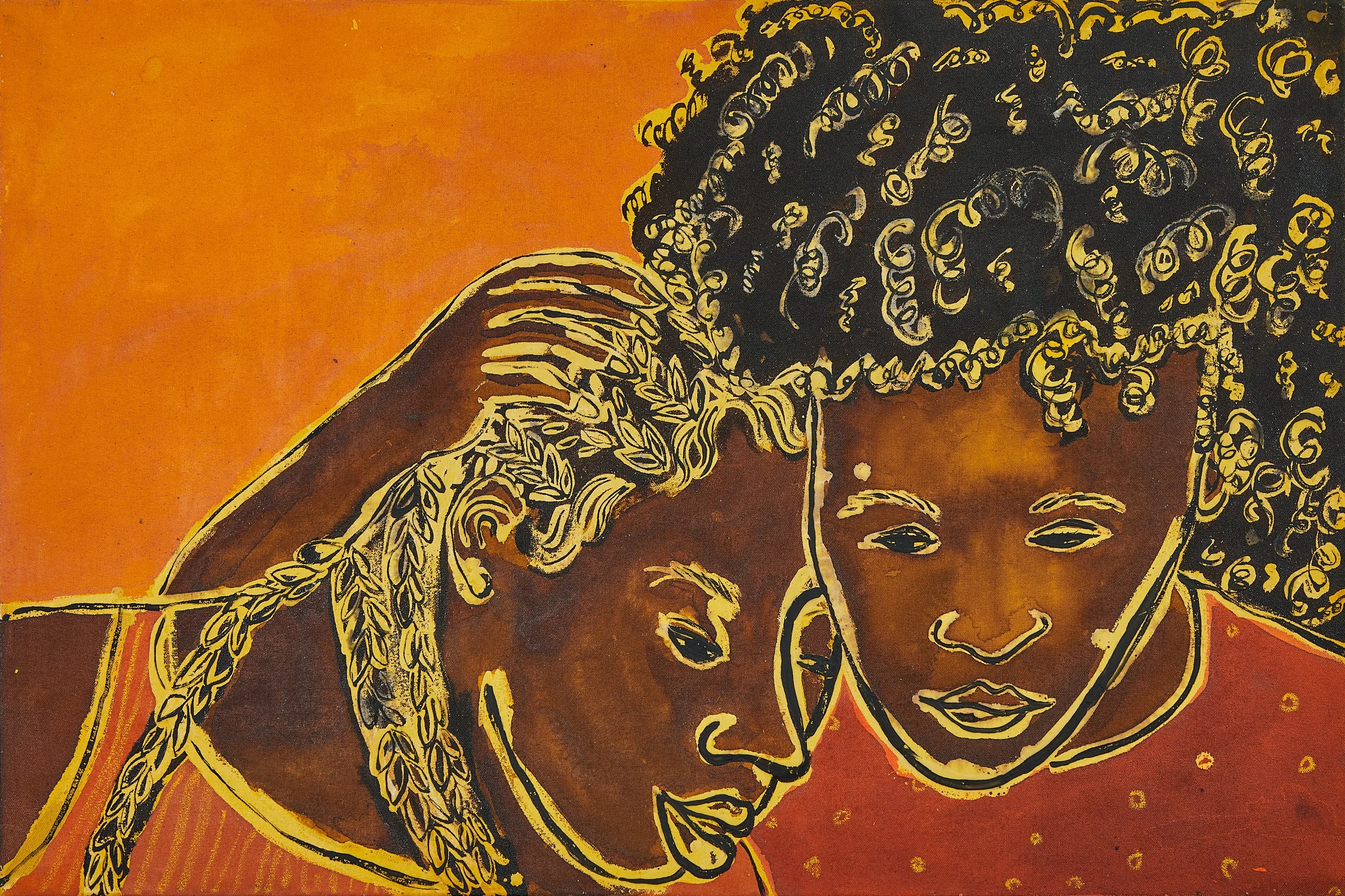Liv Little in Conversation with Sola Olulode on her Solo Exhibition: Burning, like the star that showed us to our love
British Nigerian artist Sola Olulode’s solo show Burning, like the star that showed us to our love is a celebration of the birth of love, a world in which the sun blazes and envelops the lives of a newly-formed couple.
Her paintings are layered, often over previous iterations – building texture is an integral part of her process, incorporating the odd paint splatter or wax spot into a composition like a sign of life. Olulode’s fusing of materials – dye, paints, pastels and batik – form a rich tapestry, joy bursting through the seams. Her previous body of work drew inspiration from queer club nights in the UK, a world filled with friendship, community and first dances (music has always inspired her paintings); that club scene features as the imagined meeting place for the couple who star in this latest series. Here, they exist in a world imbued with hues of yellow, which to Olulode signifies pure joy – love and optimism are strong forces within her life.
When we meet, Olulode’s studio is filled with the monochromatic schemes she has become widely recognised for – green, blue, yellow. She even has a speck of yellow paint on her nose as she talks me through each piece (of which there are many). Her studio practically glows, full of the jubilant energy radiated by these paintings and Olulode herself.
Liv Little: I would love to hear about your choice of colour palette – why yellow?
Sola Olulode: Yellow to me is joy. My work has always been about people and relationships, but it’s been broad – it could be any kind of relationship, so [in this series] I wanted to focus on a romantic one. And I thought, yellow is like that intense feeling, that joy, and I was imagining that’s the moment that I’m capturing in a relationship.
LL: Black artists are often expected to mine their trauma. Why is it that you choose to celebrate joy over and above other themes?
SO: I think I’m just tired of that narrative. I’m more drawn to and focused on happier narratives. The work for me is like therapy – I’m painting things I’d like to see in the world, things I’m thinking through, things I want to experience... The darker side of the human experience is not something that I really find myself delving into when I want to create. Maybe it’s also about my personal experience in life – like, the thing that I am consumed by is joy. I want to have narratives of queer people, just solely experiencing the good parts of love. Obviously, relationships are messy and horrible sometimes, but I just wanted to focus on this beginning phase of a couple getting to know each other.
LL: Where do you draw inspiration from?
SO: For the past couple of months, I’ve been watching Love Island in the studio. And that is interesting, because the contestants are – in this very forced way – in an early stage of building a relationship. It’s about analysing people’s behaviour, seeing how they act towards each other, in a very heightened way.
LL: Can you talk to me about how you look back on your earlier work and see differences or similarities with what you’re making now?
SO: I think often that happens when it’s the first time that I’ve used a particular material combination – because I pretty much use different materials in each one. I’m always experimenting in different ways.
I’m very rough with my paintings. I’m very expressive when I’m making them. I’m quite clumsy and dyspraxic, so I just kind of roll with the material as well. I manipulate it, but also, if it’s being stubborn and it’s working against me, then I will just work with it. I don’t try to make it do exactly what I want. I like the element of surprise; I like the difficulty, the challenge of covering a [wax] spot, or letting it become something new, a part of the painting that I didn’t intend.
LL: Your grandma was an artist and your family were always supportive of your practice, right?
SO: Yeah, she’s always been the artist of the family. She does mosaics at her church and has always painted, so whenever she comes to an exhibition, she loves to tell people I got it all from her. I’ve come from a family that’s been interested in art. Often people expect a certain narrative, like, “how did your Nigerian family feel about you going to art school?”, and I’m like, well, they were kind of fine with it. I’ve been drawing since I was a child, so it already made sense to them.
LL: You’ve spoken a little bit about things happening career-wise, faster than you maybe had envisioned for yourself – has working with people like Bolanie [Tajudeen] and Black Blossoms been an instrumental part of that journey? How about other peers?
SO: I think [those relationships are] why I’ve delved so far into the art world. Black Blossoms showed me the kind of environment of work [where] I felt like I most belonged. When I first went to their early shows, I was like, Oh, [there’s] a group of Black women and non-binary artists, they’re all showing their work and they’re all having similar conversations.
When I have loads of Black women and queer people coming to an exhibition, seeing themselves and relating to it in a way that I don’t have to explain, that’s always great. I feel like the arts community in London is very supportive, we all go to each other’s shows. I’m really excited for my friend Miranda Forrester who is having a solo show in October or November. With her and Emma Prempeh and Cece Phillips, we have these dinners in each other’s studios where we get together and talk about our work, what series we’re working on and what relationships we have with galleries... For me, that friendship is like the after-work drinks in an office.
LL: In terms of decentralising the gaze – are you making art for yourself? Who do you create for? Is it you first and then it’s a bonus when other people kind of engage with it? There’s no white gaze here; I mean, it’s very not that.
SO: Yeah, it’s definitely me first. I always say, I paint the things I want to see; things that I find cute and lovey-dovey. It’s my aesthetic. I’m very conscious of the fact that I exclusively paint Black people, Black queer people and women or non-binary people, because those are the identities that I know and understand.
Those are my experiences. I can’t really paint from a place I don’t know, and I want to share with an audience, so that other people can see [that experience] and relate to it as well. It’s important for me to have people see it, and I hope that the type of people that are seeing the work are from similar backgrounds to me, or can relate to it. I guess I create the work because I feel like I [don’t] see enough of the identities I come from, like, experiencing joy.
Words: Liv Little
Sola Olulode: Burning, like the star that showed us to our love is at Ed Cross gallery (19 Garrett Street, London EC1Y 0TY) from August 10 to September 16.
Tickets for Poetry Night, a curated evening of poetry by Sola Olulode, are available here.




